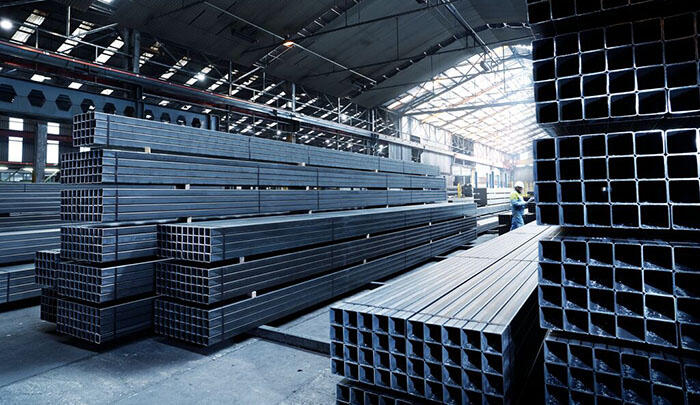As technology moves on, so the Euronorm standards which define structural hollow sections are continuing to move on with the publication of Parts 3 for both EN 10210 (for hot finished structural hollow sections) and EN 10219 (for cold formed structural hollow sections).

As technology moves on, so the Euronorm standards which define structural hollow sections are continuing to move on with the publication of Parts 3 for both EN 10210 (for hot finished structural hollow sections) and EN 10219 (for cold formed structural hollow sections).
The new Parts 3 to both standards include several new grades which can be specified, including higher strength and corrosion resistant steels. All these new grades and the new parts to the standard could cause confusion, so we have tried to answer the simple questions below.
What is covered under the new Parts 3?
Parts 3 of both EN 10210 and EN 10219 cover the availability of new steel grades for structural hollow sections, mainly with higher strength, but also some weather-resistant steels. Specifically, the grades covered include:
- EN 10210 – 3:
- Hollow sections formed hot, making use of a thermomechanical forming process with grades from S275MH to S700MH and also MLH grades – these are formed into their final shape at an elevated temperature of at least 580°C, but below the normalizing temperature used for fully normalized grades (such as S355NH). Structural hollow sections to these grades will not have the same level of metallurgical homogeneity of fully normalized products.
- Quenched and tempered steels from S460QH to S960QH and also QLH and QL1H grades – these steels achieve very high strength through a quench and temper process, first rapidly quenching from above the AC3 temperature to achieve a specific grain structure and then finally tempering at a defined temperature to achieve the desired properties.
- Steel with improved atmospheric corrosion resistance, otherwise known as weathering steels from S355J0WH to S500K2WH
- EN 10219 – 3:
- Hollow sections formed cold from a feedstock which has been thermomechanically rolled with grades from S500MH to S960MH and also MLH grades up to S700MLH – these hollow sections are cold-formed using thermomechanical formed strip steel, so have different properties to those under EN 10210.
- Quenched and tempered steels – feedstock condition QT – from S460QH to S960QH and also QLH and QL1H grades – these steels achieve very high strength through a quench and temper process, first rapidly quenching from above the AC3 temperature to achieve a specific grain structure and then finally tempering at a defined temperature to achieve the desired properties. Under EN 10219-3, this standard covers tubes made usually by the SAW process from Q&T plate feedstock.
- Steel with improved atmospheric corrosion resistance, otherwise known as weathering steels from S355J0WH to S500K2WH
Why are the same grades under both EN 10210 and EN 10219?
It is important to understand that the difference between EN 10210 and EN 10219 relates to the way that the hollow sections are formed and the effect that this has on their final properties. Whilst you can see grades with the same nomenclature between the two standards, these actually refer to different things.
- In EN 10210, the grade refers to the steel in the finished hollow section;
- In EN 10219, the grade refers to the steel feedstock used for cold-forming of the hollow section, so the metallurgy will be modified in the cold forming process.
Because of this difference, it is very important to be sure to specify the hollow section fully, using both the standard number (EN 10210 or EN 10219) as well as the grade (eg S460MH).
Why are these new grade in Parts 3 rather than revising the existing standards?
Parts 1 of both EN 10210 and EN 10219 are both published in the Official Journal of the European Union (OJEU) under the Construction Product Regulations (CPR) which enables CE marking of all the products included in them. In other words, the Parts 1 have a special status in qualifying products for CE marking under the CPR.
The special status under the CPR of the Parts 1 means that there is additional scrutiny required to modify these parts of the standard. Therefore, the committee who create these standards have taken the view to publish these new grades, initially at least, within a new part (Parts 3) which sits outside of the requirements of the CPR, enabling the relatively rapid inclusion of these grades into the Euronorm standards.
It is important to note that EN 10210-3 and EN 10219-3 are not referenced in the CPR and therefore grades included in these new Parts 3 cannot be CE-marked.
When should I use Parts 3?
Parts 3 of both EN 10210 and EN 10219 include a wide range of new steel grades and while these cannot be CE marked for use in construction, this points the way for the future of structural hollow sections and enables steel makers to further innovate and deliver these new steel grades, particularly high strength grades.
At Tata Steel, we are at the forefront of steel grade development across our multi-sector product range. With the introduction of our Celsius S460NH, we are now towards the limit of what is feasible within Part 1 of EN 10210 and future development will make use of some of these advanced grades in Part 3. Meanwhile in our Hybox range of cold formed hollow sections, we are now offering up to S700MH in certain sizes and Part 3 enables greater customer confidence in this as well as future advanced grade steels.











































































































































































